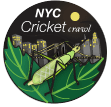 What Species Will Be Counted?
What Species Will Be Counted?
This is the hardest part of your job!
You need to memorize the calls of the 7 targeted species listed below.
Fortunately they are easy to learn.
The online sound files listed below are of high sound quality.
So go out tonight and employ your new awareness of night sounds while you walk the dog.
NEW! Quick download files for all 7 species are located at http://drop.io/nyccricketcrawl
(many thanks to one of our extended cricket crawl helpers).
NEWER! Load the target species onto your iPHONE or iPOD.
There are many species of crickets and katydids that are not part of this count. In many cases most of the sounds
you are hearing at night come from there groups....these form the background of soft churrs and trills that emanate from a series of
different small ground and tree crickets (for a real challenge, try and locate these singers sometime....). Because many of these species can be difficult to separate from
one another we are not asking you to count them. However, we do provide links to them
below as you may be interested in checking out and taking the time to learn more about these species, references and pictures are at Lang Elliott
and Wil Hershberger’s (WH) and
Tom Walker’s (TW) wonderful web sites.
Cricket
Targets
Photographs courtesy of Wil Hershberger and Lang Elliott
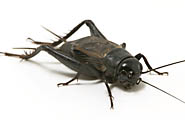
|
Northern Fall Field
Cricket Gryllus pennsylvanicus
(EH,
TW) – This is large black cricket
that comes into your house in the Fall, everyone
has heard these.
|
|
Jumping Bush Cricket
Orocharis saltator (EH,
TW)
-- This is an ubiquitous cricket that gives periodic SINGLE PEEP call and lives throughout the
shrubbery surrounding suburban and city yards.
|

|
Note that if you have significant hearing loss you are unlikely to hear some of the species below
Katydid Targets
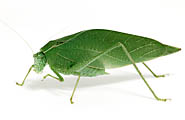
|
Greater Anglewing Microcentrum rhombifolium
(EH,
TW)
– A leaf-like katydid that lives at the very top of shade trees.
It gives a distinct set of tics that increases greatly in speed toward the end…LIKE A RAPIDLY BOUNDING BALL.
|
|
Lesser Anglewing Microcentrum retinerve
(EH,
TW) – Another
tree-top species, usually common in urban areas,
this species has a DISTINCT PATTERN OF 2-3 SHUSHS WITH LONG PAUSES INBETWEEN. Can be confused with the Common True, which calls continuously without pauses.
|

|
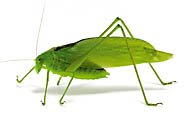
| Oblong-winged Katydid Amblycorypha oblongifolia
(EH,
TW) – A species of the understory, low shrubs, and lower layers of the forest, it will be interesting to see this
species pattern in the city.
This species has a unique TWO-PART CALL -ZZZZZ-TIC - GIVEN EVERY FEW SECONDS
|
|
Fork-tailed Katydid
Scudderia furcata
EH,
TW)
– This katydid calls from the shrub layer, likes individual young street trees, but will call up to the
tops of trees and gives a SINGLE LOUD TIC as its call. This note can be very much like that of the note that the Greater Anglewing will give (as an alternative to is usually bouncing tics), but the Greater Anglewing gives its
note only very uncommonly (once every few minutes) and
the Fork-tailed will give its note several times a minute.
|

|
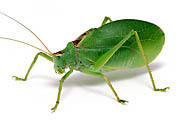
|
Common True Katydid Pterophylla camellifolia
(EH,
TW)
-- This is a katydid of the forest, apparently extirpated from the NYC region during the Cities' early development,
we will be especially looking for this animal during the survey -- An easy one to identify it calls non-stop giving
CONTINUOUS SERIES OF SHUSHES often in groups of 2's and 3's.
|
Other Sorts of Things You May Also Hear, but are Either Uncommon or the Species Can't be Readily Told Apart
(Warning! These can be the most common sounds you hear, you just don't need to count them for this survey)
(But hey, no reason not to try and figure them out)
Ground Crickets (EH, TW)
– Tiny crickets that make tiny CHURRING sounds in the grass.
Tree Crickets (EH, TW) – These make SWEET CHORUSES that call from the shrubs and low vegetation>
Northern Mole Cricket - Neocurtilla hexadactyla
(EH, TW)
– A cricket of wetlands and wet meadows, has a very distinctive low frog-like,
call that it gives over and over. Uncommon but would be interesting to find any populations.
Conehead Katydids
(EH, TW)
– Yes, they do have coneheads and they give very LOUD BUZZING sounds that lack tonality
and are mostly white noise. Most hang out in tall grass.
Meadow Katydids
(EH,
TW)
– Another group that hangs out in tall grasses, these species are
good tests of your hearing. Most have very high pitched calls that are a combination of tics, and gentle buzzes…often MIMICKING A LAWN SPRINKLER.
Help me out Here, What is the Difference Between Crickets, Katydids, and Cicadas?
Ok, the simplest answer is that crickets and katydids largely call at night while Cicadas almost entirely call during the day time. Crickets are sweet sounding
and musical while katydids and cicadas are buzzy, raspy, and often a bit harsh sounding. Biologically, crickets and katydids are closely related while cicadas come
from an entirely different Order of insects. Tom Walker has a good discussion of the differences at his web site.
Here are the SIMPLE INSTRUCTIONS for doing a cricket and katydid count. Here is the
SIMPLE FORM that you can
use when you go out in the field.
Excuse my wandering.
How can one be orderly with this?
It's like counting leaves in a garden,
along with the sound notes of partridges,
and crows.
Sometimes organization
and computation become absurd.
- Rumi
 What Species Will Be Counted?
What Species Will Be Counted?





